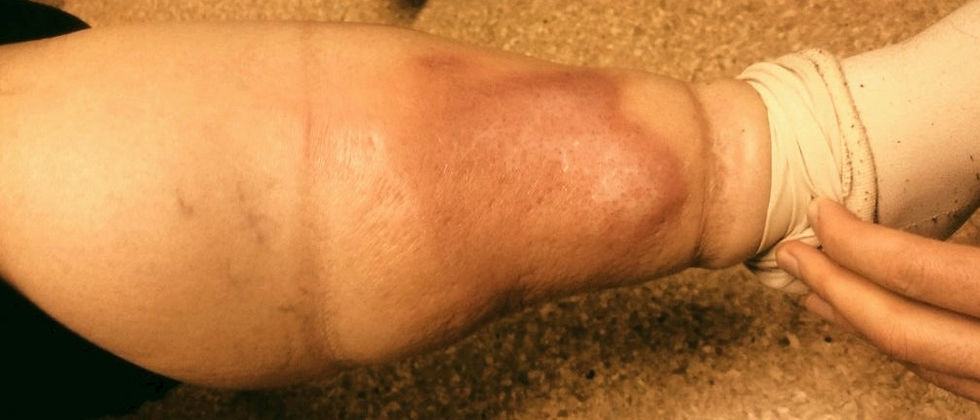What is Lymphedema?
- Gianna Chandler
- Mar 8, 2024
- 3 min read
Pictured: An edematous leg with erysipelas, a dermal skin infection. Lymphatic disruption is a major risk factor for this infection. Source.
Normal circulation is not solely dependent on arteries, veins, and capillaries. While blood pushes through these vessels, some materials leak through the vessel walls. Regulation of this leakage is critical in maintaining homeostasis, while the fluid itself provides oxygen and nutrients to its targeted tissues. The unabsorbed waste-fluid mix that accumulates outside of the vasculature is called lymph and is absorbed into lymphatic capillaries. Typical lymph consists of water, fat cells, abnormal cells, cell debris, proteins, white blood cells, and bacteria.
The lymphatic system is the collective of organs, tissues, and vessels that manage this lymph. Its components are:
bone marrow
lymph nodes
lymphatic vessels
collecting ducts
tonsils
adenoids
the thymus
mucosa-associated lymphoid tissue
the spleen
While in the lymphatic system, the lymph flows through specialized vessels until it reaches the lymph nodes, which cleanse the fluid of impurities. The vessels carry clean lymph to the deep subclavian vein in the chest, returning it to circulation. Disruption of the lymphatic system, which is most commonly seen in the lower extremities, is called lymphedema.
Signs and Symptoms of Lymphedema
If lymph cannot drain, it pools in the interstitial space – the space between blood vessels and cells – and causes the area to swell. The tissues exposed to the protein-rich lymph begin to thicken and scar in a process called fibrosis.
At the lowest stage, the swelling is not evident. Typically, the first sign of disease is swelling of the foot, which may spontaneously resolve. If the disease worsens, the swelling will progress up the affected limb, and elevation will not help.
Other important signs and symptoms of lymphedema include
intense itching (pruritus) to the affected limb
recurrent infections/cellulitis in the affected area
a positive Stemmer’s sign, when the skin on the dorsal foot beneath the second toe does not fold when pinched
redness and dark discoloration
lymphangiomas or blisters filled with lymph
skin fissures
venous ulcers
same circumference from ankle to knee
“cobblestone” skin appearance
hardening of the skin
elephantiasis
Lymphedema patients must protect their skin from infection, trauma, and hyperkeratosis. The use of moisturizers and sun protectants is encouraged. The lymphedema patient should also maintain good nail hygiene, avoid extreme heat or cold on the affected limb, and be extremely careful with razors. Weight management is a consideration for overweight and obese patients. Treatment with compression therapy, manual drainage, surgery, or medications is focused on interrupting the disease process and managing symptoms, as lymphedema has no known cure.
Recent Scientific Developments
You may have heard that swelling of the extremities, especially the legs, is associated with conditions like venous insufficiency and congestive heart failure. Infections like cellulitis can also cause painful, local swelling in affected areas. In recent years, however, there has been a movement to identify any swelling as lymphedema.
Surgery, radiation, obesity, cancer, infection, and familial history have been the most well-known risk factors for lymphedema for many years. Lymphedema was classically thought of as its own form of edema, distinct from other causes, partly because scientists used to think most of the interstitial fluid that leaks out of the capillary system is returned directly to the veins. However, a recent literature review spanning eleven years from Wound Prevention claims:
"… nearly 100% of all fluid and proteins moving from the blood capillaries into the interstitial space is subsequently absorbed by the lymphatic capillaries alone. "
Because of this finding and many others, the authors claim that any swelling, regardless of duration, severity, and underlying cause, involves some amount of lymphedema. The authors of that review go on to advocate for earlier recognition, diagnosis, and treatment of lymphedema in patients who would otherwise develop debilitating symptoms.
Resources
Please see the patient resource websites below if you or a loved one is suffering from lymphedema.
References
Assessed and Endorsed by the MedReport Medical Review Board







